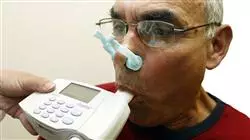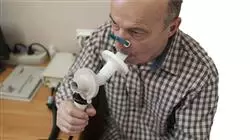University certificate
The world's largest faculty of medicine”
Introduction to the Program
This Hybrid professional master’s degree provides you with the most up-to-date and innovative perspective on Respiratory Physiotherapy used in Rehabilitation Medicine"

Spirometries, stress tests, or lung expansion techniques are commonly used by health professionals responsible for performing Respiratory Physiotherapy in Rehabilitation Medicine. However, with the emergence of the pandemic caused by SARS-CoV-2, clinical cases requiring this care have multiplied, both in pediatric and adult patients.
A reality that has boosted the services provided by these units and, at the same time, demands more specialized medical professionals who are up-to-date with the most effective techniques and the latest instrumental devices. For this reason, TECH has created this university degree, which offers specialists innovative multimedia content that is 100% online and a practical internship at a prestigious hospital.
In this way, the physician will be able to stay informed about recent advances in instrumental techniques used in Pediatric Respiratory Physiotherapy, for patients with COPD in mechanical ventilation, or patients who have suffered the consequences of COVID-19. All of this is provided with content that can be easily accessed from any device with an Internet connection at any time of day, without fixed class schedules, and with flexibility to balance it with daily professional duties.
As the culmination, TECH has designed a program that offers health professionals the opportunity to up date their competencies and skills in Respiratory Physiotherapy in Rehabilitation Medicine through a 3-week stay in a high-level clinical environment.
Throughout this period, they will be supervised by a specialist in this field who will introduce them to the latest advances in this field.
The teaching materials of this program, elaborated by these specialists, have contents that are completely applicable to your professional experiences"
This Hybrid professional master’s degree in Respiratory Physiotherapy in Rehabilitation Medicine contains the most complete and up-to-date scientific program on the market. The most important features include:
- Development of more than 100 clinical cases presented by Physiotherapist professionals with a wide experience in Medical Rehabilitation and Respiratory Physiotherapy
- The graphic, schematic, and practical contents with which they are created, provide scientific and practical information on the disciplines that are essential for professional practice
- Assessment and application of the most innovative techniques in Respiratory Physiotherapy
- Comprehensive systematic action plans for major respiratory pathologies
- Presentation of practical workshops on diagnostic and therapeutic techniques for patients with respiratory pathologies
- An algorithm-based interactive learning system for decision-making in the clinical situations presented throughout the course.
- Practical clinical guides on approaching different pathologies
- With a special emphasis on evidence-based medicine and research methodologies in patients with respiratory pathologies
- All of this will be complemented by theoretical lessons, questions to the expert, debate forums on controversial topics, and individual reflection assignments.
- The content is accessible from any fixed or portable device with an Internet connection
- Furthermore, you will be able to carry out a clinical internship in one of the best hospital centers
Take an intensive 3-week internship in a prestigious center and acquire all the knowledge to grow personally and professionally"
This Master's program, which has a professionalizing nature and a hybrid modality, is aimed at updating medical professionals who perform their functions in Rehabilitation units, and who require a high level of qualification. The contents are based on the latest scientific evidence, and oriented in an educational way to integrate theoretical knowledge into medical and the theoretical-practical elements will facilitate knowledge up-to-date and decision-making in patient management.
Thanks to its multimedia content created with the latest educational technology, it will enable medical professional to achieve situated and contextual learning, i.e., a simulated environment that will provide immersive learning programmed to train for real-life situations. This program is designed around Problem-Based Learning, whereby the physician must try to solve the different professional practice situations that arise during the course. For this purpose, the students will be assisted by an innovative interactive video system created by renowned and experienced experts.
This Hybrid professional master’s degree provides you with the latest advancements in the recovery of COVID patients with severe respiratory issues”

Update your knowledge with the best-specialized teaching staff and extensive experience in Respiratory Physiotherapy”
Why study at TECH?
TECH is the world’s largest online university. With an impressive catalog of more than 14,000 university programs available in 11 languages, it is positioned as a leader in employability, with a 99% job placement rate. In addition, it relies on an enormous faculty of more than 6,000 professors of the highest international renown.

Study at the world's largest online university and guarantee your professional success. The future starts at TECH”
The world’s best online university according to FORBES
The prestigious Forbes magazine, specialized in business and finance, has highlighted TECH as “the world's best online university” This is what they have recently stated in an article in their digital edition in which they echo the success story of this institution, “thanks to the academic offer it provides, the selection of its teaching staff, and an innovative learning method aimed at educating the professionals of the future”
A revolutionary study method, a cutting-edge faculty and a practical focus: the key to TECH's success.
The most complete study plans on the university scene
TECH offers the most complete study plans on the university scene, with syllabuses that cover fundamental concepts and, at the same time, the main scientific advances in their specific scientific areas. In addition, these programs are continuously being updated to guarantee students the academic vanguard and the most in-demand professional skills. In this way, the university's qualifications provide its graduates with a significant advantage to propel their careers to success.
TECH offers the most comprehensive and intensive study plans on the current university scene.
A world-class teaching staff
TECH's teaching staff is made up of more than 6,000 professors with the highest international recognition. Professors, researchers and top executives of multinational companies, including Isaiah Covington, performance coach of the Boston Celtics; Magda Romanska, principal investigator at Harvard MetaLAB; Ignacio Wistumba, chairman of the department of translational molecular pathology at MD Anderson Cancer Center; and D.W. Pine, creative director of TIME magazine, among others.
Internationally renowned experts, specialized in different branches of Health, Technology, Communication and Business, form part of the TECH faculty.
A unique learning method
TECH is the first university to use Relearning in all its programs. It is the best online learning methodology, accredited with international teaching quality certifications, provided by prestigious educational agencies. In addition, this disruptive educational model is complemented with the “Case Method”, thereby setting up a unique online teaching strategy. Innovative teaching resources are also implemented, including detailed videos, infographics and interactive summaries.
TECH combines Relearning and the Case Method in all its university programs to guarantee excellent theoretical and practical learning, studying whenever and wherever you want.
The world's largest online university
TECH is the world’s largest online university. We are the largest educational institution, with the best and widest online educational catalog, one hundred percent online and covering the vast majority of areas of knowledge. We offer a large selection of our own degrees and accredited online undergraduate and postgraduate degrees. In total, more than 14,000 university degrees, in eleven different languages, make us the largest educational largest in the world.
TECH has the world's most extensive catalog of academic and official programs, available in more than 11 languages.
Google Premier Partner
The American technology giant has awarded TECH the Google Google Premier Partner badge. This award, which is only available to 3% of the world's companies, highlights the efficient, flexible and tailored experience that this university provides to students. The recognition as a Google Premier Partner not only accredits the maximum rigor, performance and investment in TECH's digital infrastructures, but also places this university as one of the world's leading technology companies.
Google has positioned TECH in the top 3% of the world's most important technology companies by awarding it its Google Premier Partner badge.
The official online university of the NBA
TECH is the official online university of the NBA. Thanks to our agreement with the biggest league in basketball, we offer our students exclusive university programs, as well as a wide variety of educational resources focused on the business of the league and other areas of the sports industry. Each program is made up of a uniquely designed syllabus and features exceptional guest hosts: professionals with a distinguished sports background who will offer their expertise on the most relevant topics.
TECH has been selected by the NBA, the world's top basketball league, as its official online university.
The top-rated university by its students
Students have positioned TECH as the world's top-rated university on the main review websites, with a highest rating of 4.9 out of 5, obtained from more than 1,000 reviews. These results consolidate TECH as the benchmark university institution at an international level, reflecting the excellence and positive impact of its educational model.” reflecting the excellence and positive impact of its educational model.”
TECH is the world’s top-rated university by its students.
Leaders in employability
TECH has managed to become the leading university in employability. 99% of its students obtain jobs in the academic field they have studied, within one year of completing any of the university's programs. A similar number achieve immediate career enhancement. All this thanks to a study methodology that bases its effectiveness on the acquisition of practical skills, which are absolutely necessary for professional development.
99% of TECH graduates find a job within a year of completing their studies.
Hybrid Professional Master's Degree in Respiratory Physiotherapy in Rehabilitative Medicine
Are you looking for a quality specialization that suits your needs? Our blended classroom program combines the best of both worlds: 100% online theory and face-to-face practice in a specialized clinic, Power your career in the field of Respiratory Physiotherapy in Rehabilitative Medicine with TECH Global University's Hybrid Professional Master's Degree! Thanks to our online theory classes, you will be able to access the most up-to-date knowledge in respiratory physiotherapy from anywhere and on the schedule that best fits your routine. Through our virtual learning platform, you will have access to interactive materials, recorded lectures and multimedia resources that will allow you to acquire a solid foundation of theoretical knowledge. We know that practice is fundamental in the field of respiratory physiotherapy. That's why our program includes face-to-face internships at a renowned clinic, where you will work directly with patients and apply your skills under the supervision of experienced professionals. This internship will provide you with valuable hands-on experience and allow you to develop the skills necessary to meet the challenges of the field of rehabilitative medicine.
Upgrade yourself at TECH Medical School, the best in the online market
At TECH Global University, we pride ourselves on offering quality education that is relevant to today's working world. Our teaching team is composed of highly qualified professionals and experts in the field of respiratory physiotherapy, who will guide you throughout your educational process. Don't miss the opportunity to boost your career in respiratory physiotherapy in rehabilitative medicine. Join TECH Global University's Hybrid Professional Master's Degree in Respiratory Physical Therapy in Rehabilitative Medicine and gain the skills you need to excel in this ever-growing field - enroll now and begin your path to professional success!







